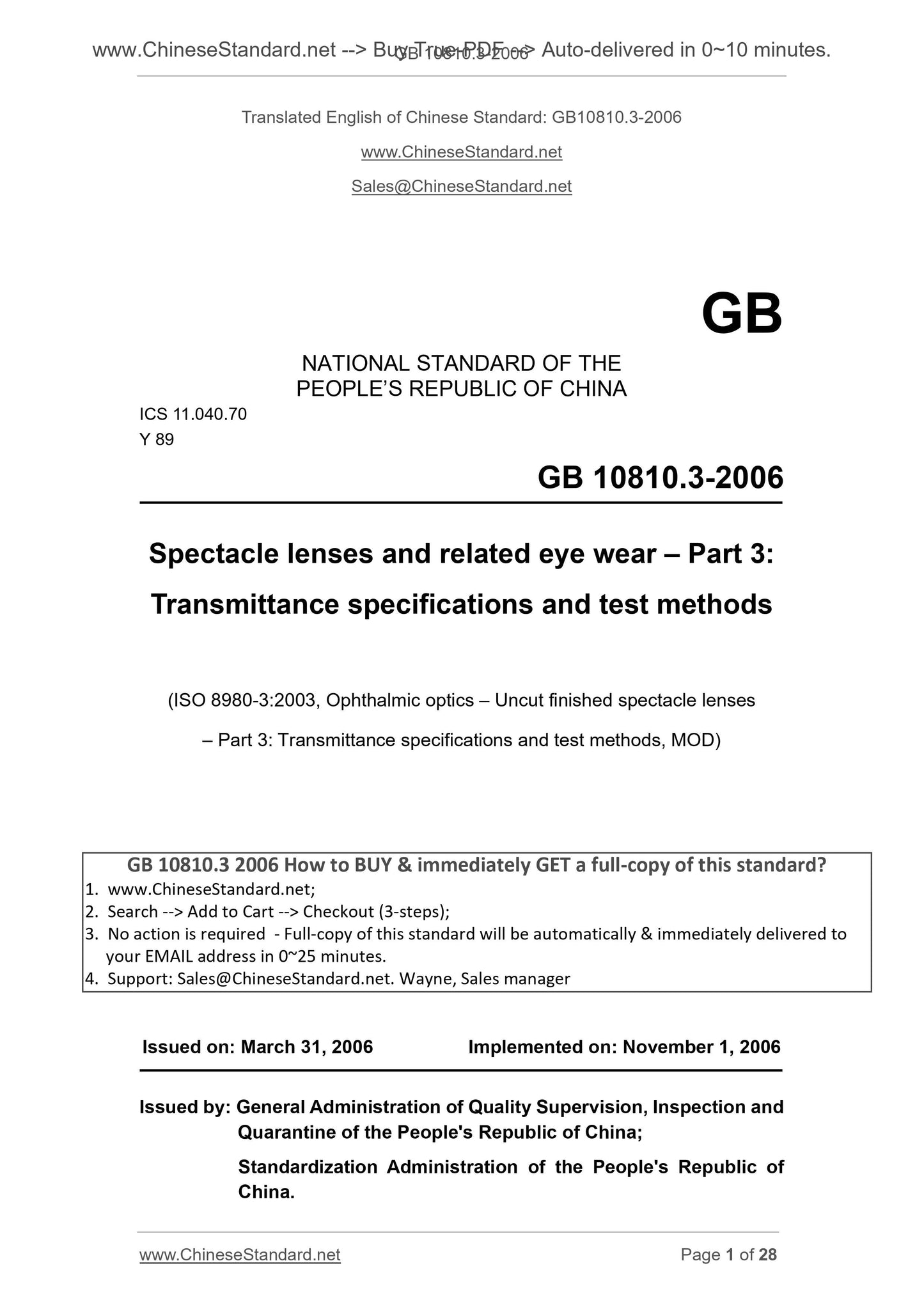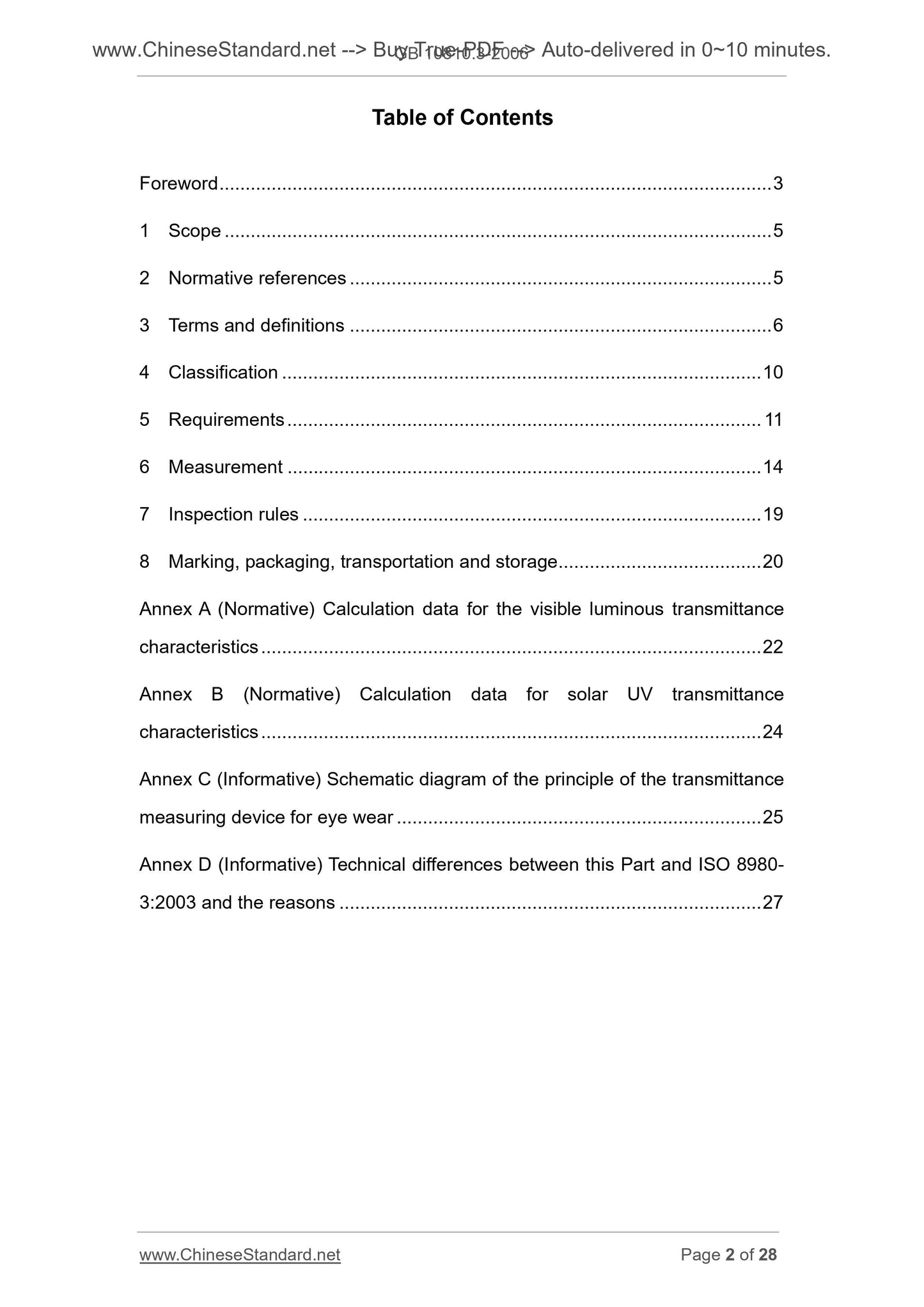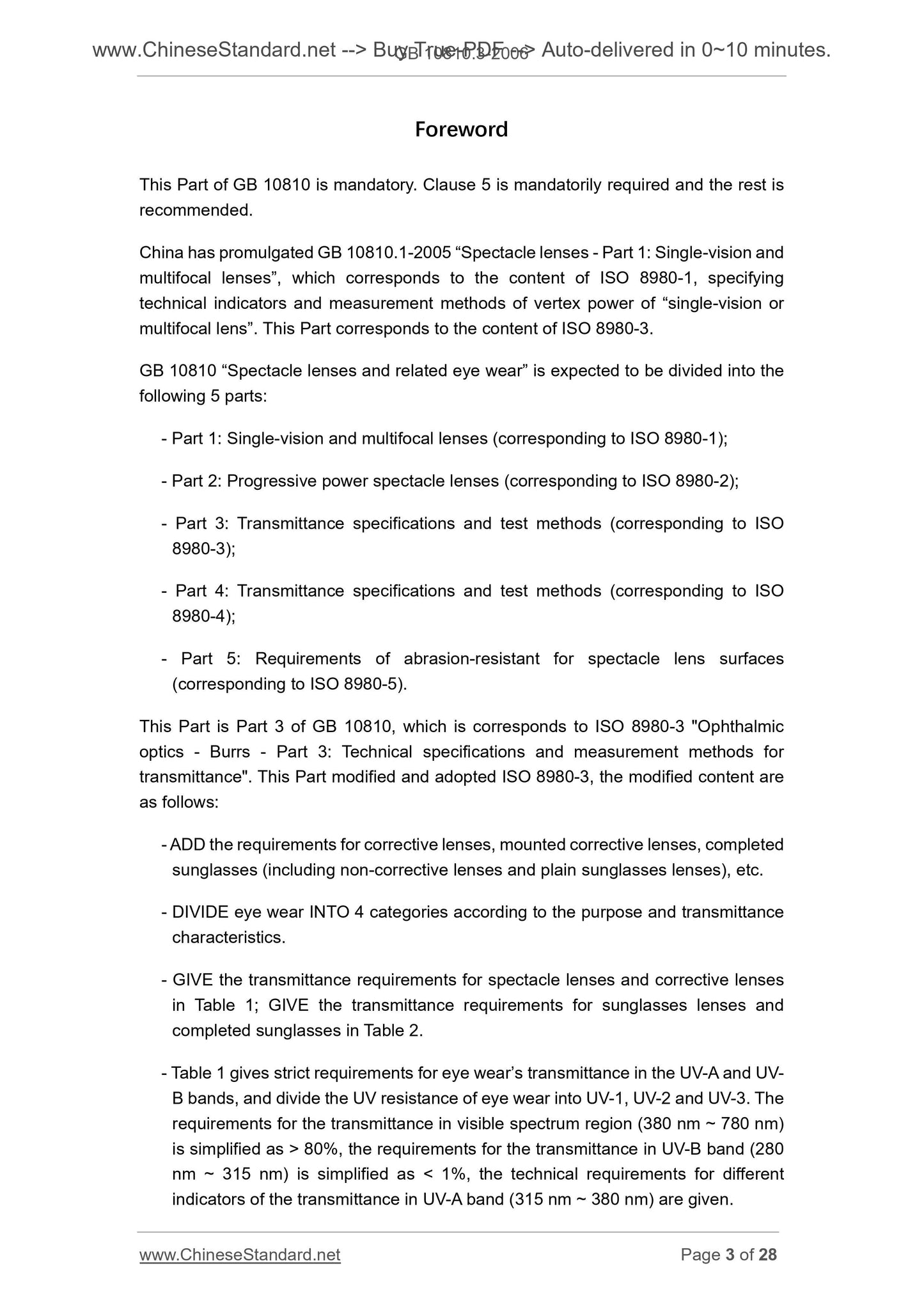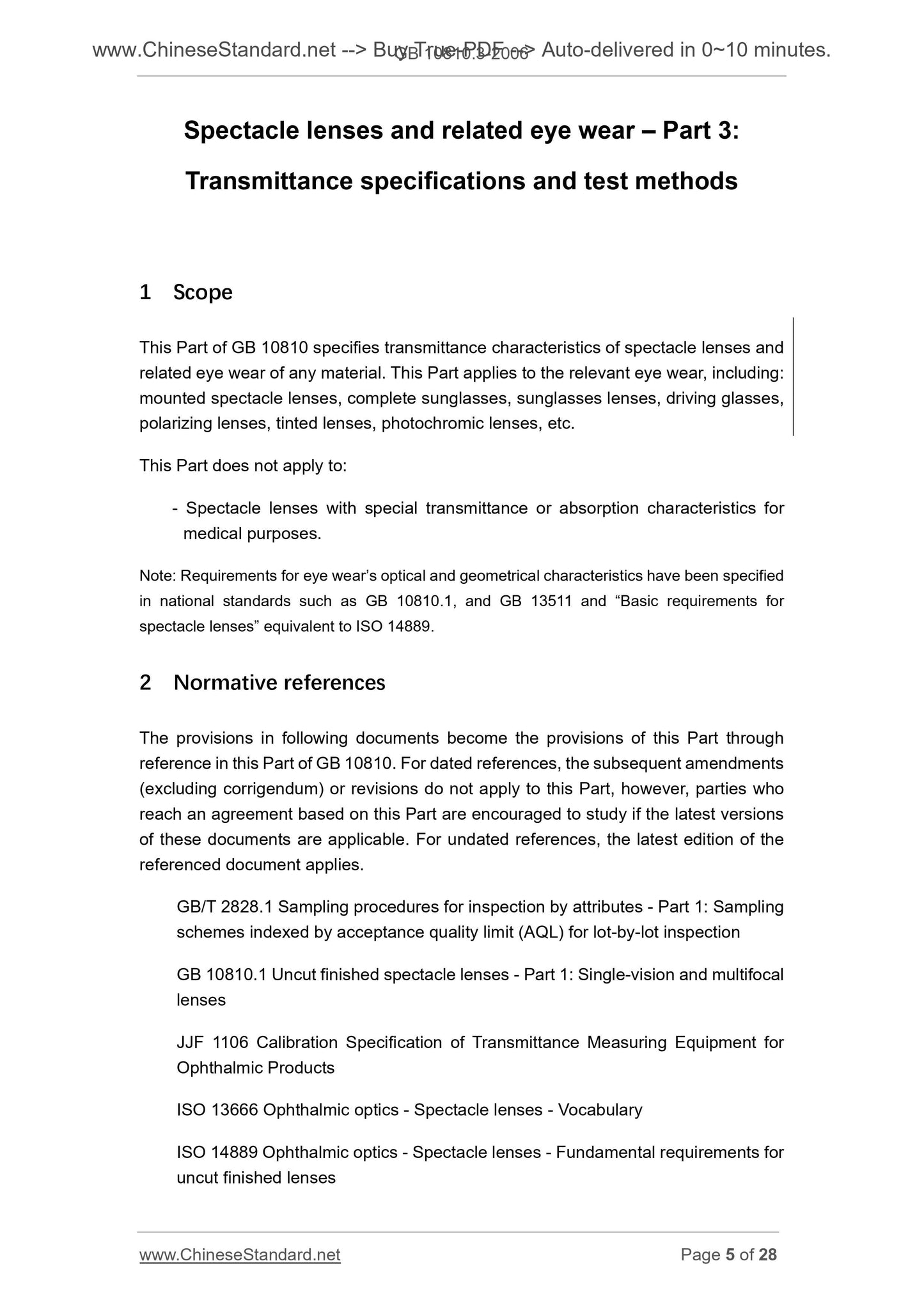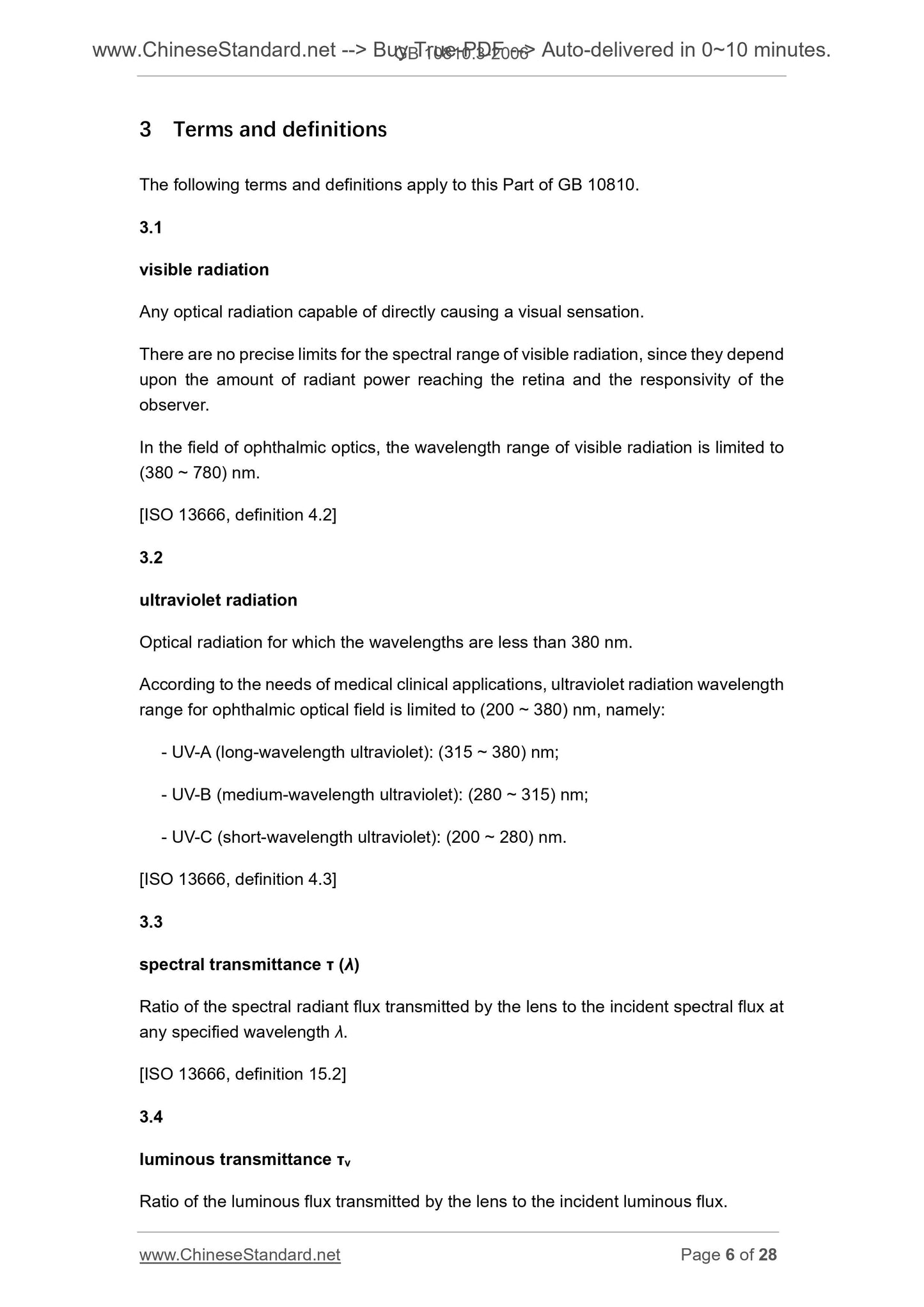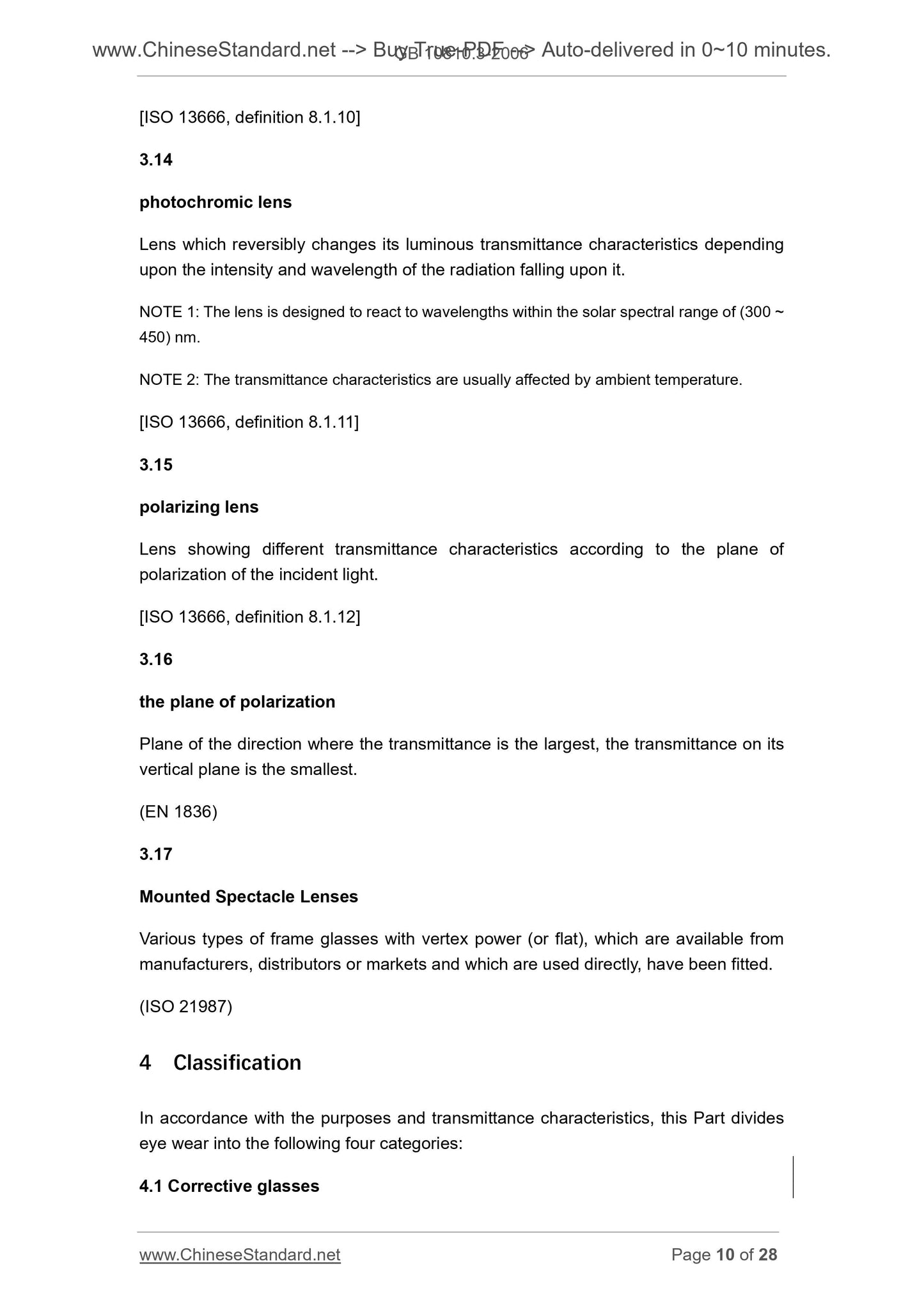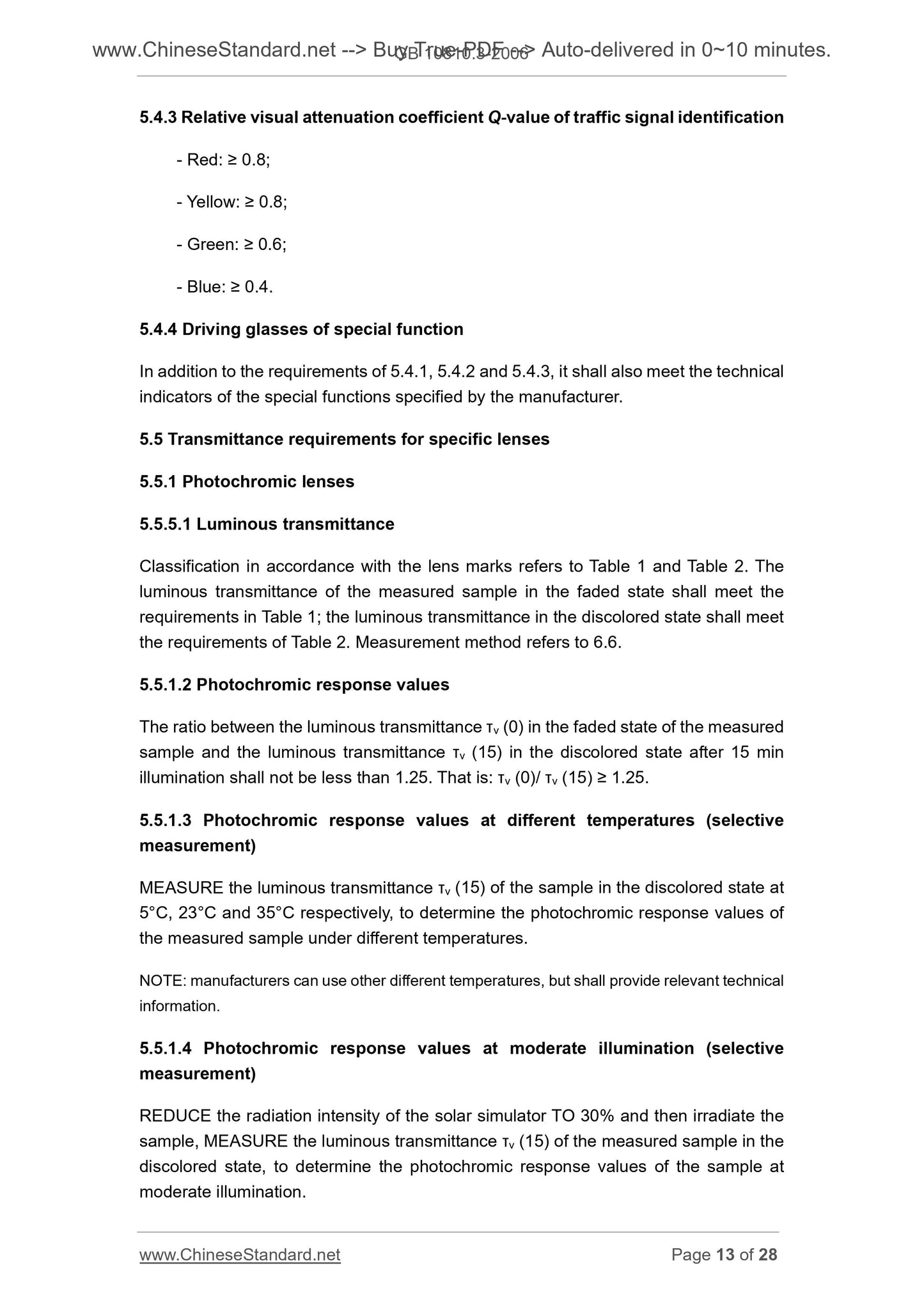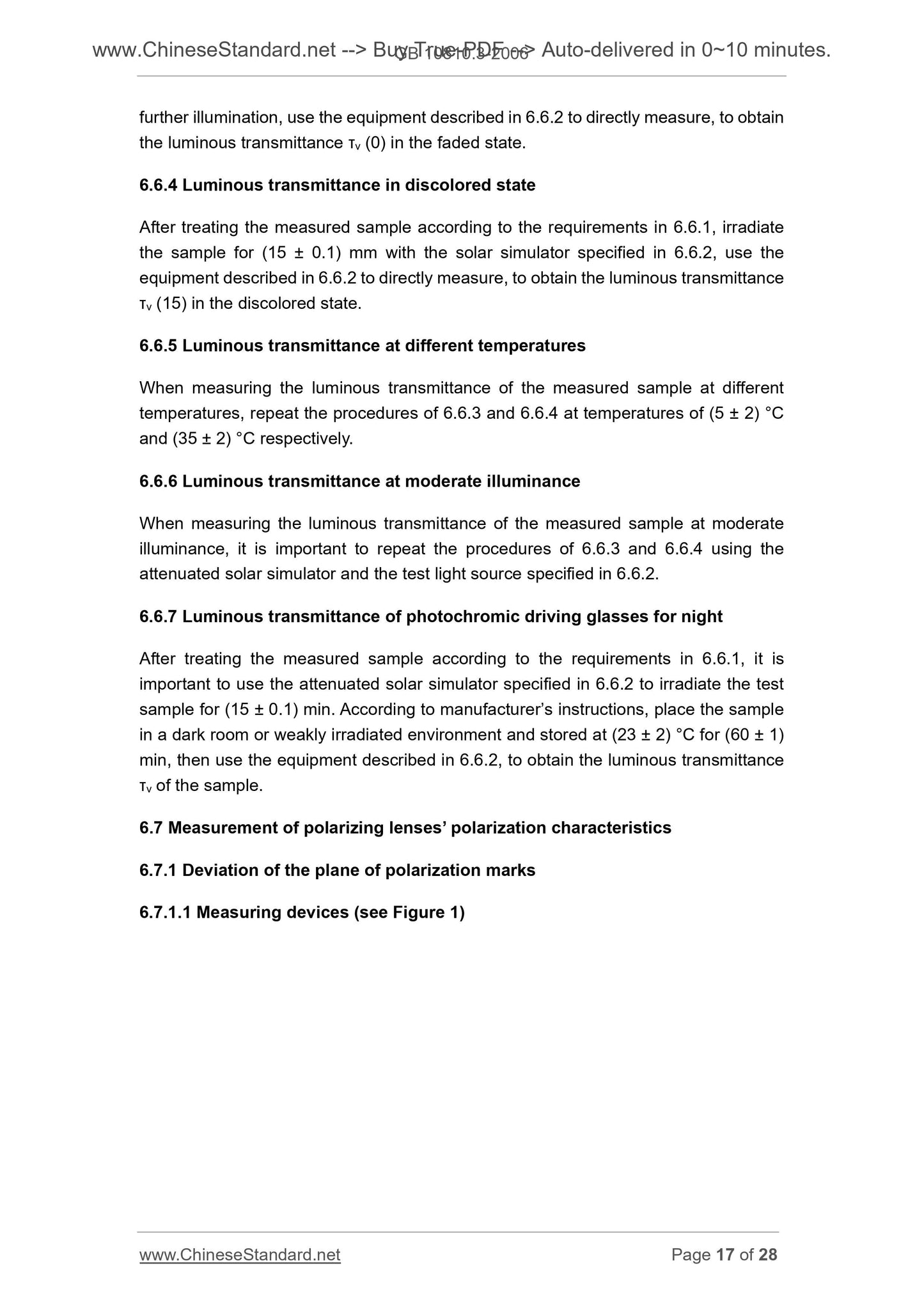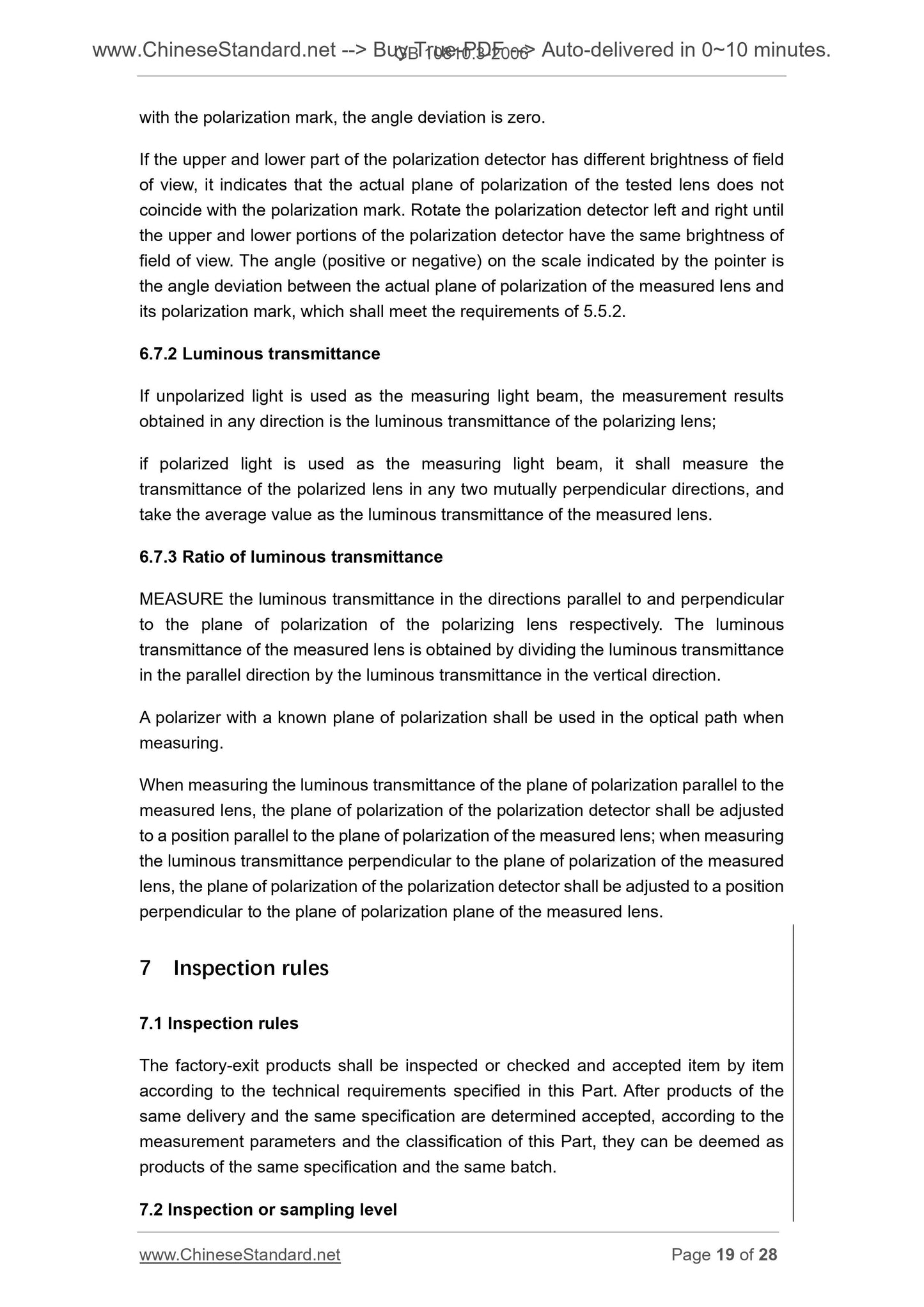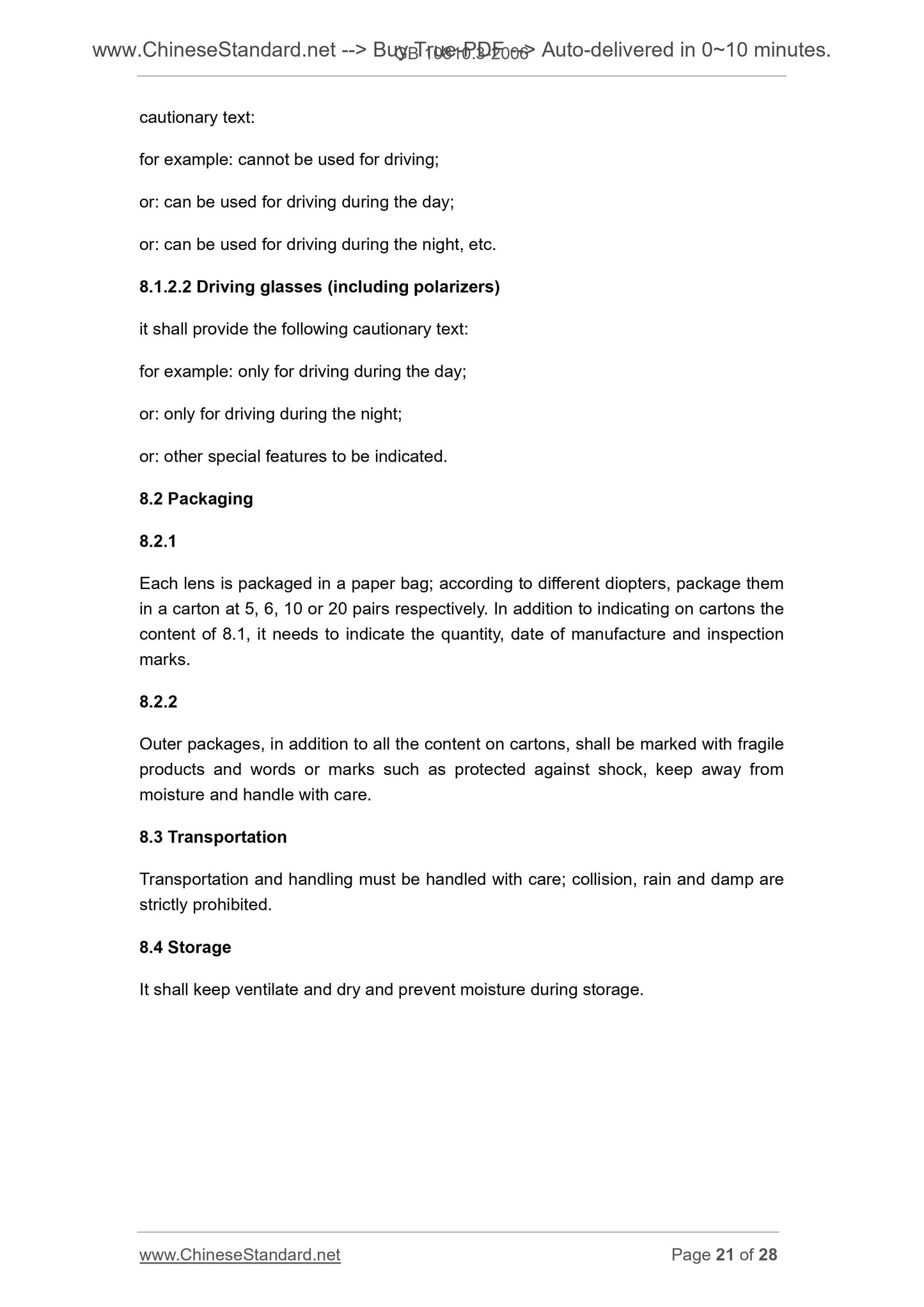1
/
of
11
www.ChineseStandard.us -- Field Test Asia Pte. Ltd.
GB 10810.3-2006 English PDF
GB 10810.3-2006 English PDF
Regular price
$85.00
Regular price
Sale price
$85.00
Unit price
/
per
Shipping calculated at checkout.
Couldn't load pickup availability
GB 10810.3-2006: Spectacle lenses and related eye wear -- Part 3: Transmittance specifications and test methods
Delivery: 9 seconds. Download (& Email) true-PDF + Invoice.
Get Quotation: Click GB 10810.3-2006 (Self-service in 1-minute)
Historical versions (Master-website): GB 10810.3-2006
Preview True-PDF (Reload/Scroll-down if blank)
GB 10810.3-2006
GB
NATIONAL STANDARD OF THE
PEOPLE’S REPUBLIC OF CHINA
ICS 11.040.70
Y 89
Spectacle lenses and related eye wear – Part 3.
Transmittance specifications and test methods
眼镜镜片及相关眼镜产品
(ISO 8980-3.2003, Ophthalmic optics – Uncut finished spectacle lenses –
Part 3. Transmittance specifications and test methods, MOD)
ISSUED ON. MARCH 31, 2006
IMPLEMENTED ON. NOVEMBER 1, 2006
Issued by. General Administration of Quality Supervision, Inspection and
Quarantine of the People's Republic of China;
Standardization Administration of the People's Republic of
China.
Table of Contents
Foreword ... 3
1 Scope ... 5
2 Normative references ... 5
3 Terms and definitions ... 6
4 Classification ... 10
5 Requirements ... 11
6 Measurement ... 14
7 Inspection rules ... 19
8 Marking, packaging, transportation and storage ... 20
Annex A (Normative) Calculation data for the visible luminous transmittance
characteristics ... 22
Annex B (Normative) Calculation data for solar UV transmittance
characteristics ... 24
Annex C (Informative) Schematic diagram of the principle of the transmittance
measuring device for eye wear ... 25
Annex D (Informative) Technical differences between this Part and ISO 8980-
3.2003 and the reasons ... 27
Foreword
This Part of GB 10810 is mandatory. Clause 5 is mandatorily required and the rest is
recommended.
China has promulgated GB 10810.1-2005 “Spectacle lenses - Part 1. Single-vision and
multifocal lenses”, which corresponds to the content of ISO 8980-1, specifying
technical indicators and measurement methods of vertex power of “single-vision or
multifocal lens”. This Part corresponds to the content of ISO 8980-3.
GB 10810 “Spectacle lenses and related eye wear” is expected to be divided into the
following 5 parts.
- Part 1. Single-vision and multifocal lenses (corresponding to ISO 8980-1);
- Part 2. Progressive power spectacle lenses (corresponding to ISO 8980-2);
- Part 3. Transmittance specifications and test methods (corresponding to ISO
8980-3);
- Part 4. Transmittance specifications and test methods (corresponding to ISO
8980-4);
- Part 5. Requirements of abrasion-resistant for spectacle lens surfaces
(corresponding to ISO 8980-5).
This Part is Part 3 of GB 10810, which is corresponds to ISO 8980-3 "Ophthalmic
optics - Burrs - Part 3. Technical specifications and measurement methods for
transmittance". This Part modified and adopted ISO 8980-3, the modified content are
as follows.
- ADD the requirements for corrective lenses, mounted corrective lenses, completed
sunglasses (including non-corrective lenses and plain sunglasses lenses), etc.
- DIVIDE eye wear INTO 4 categories according to the purpose and transmittance
characteristics.
- GIVE the transmittance requirements for spectacle lenses and corrective lenses
in Table 1; GIVE the transmittance requirements for sunglasses lenses and
completed sunglasses in Table 2.
- Table 1 gives strict requirements for eye wear’s transmittance in the UV-A and UV-
B bands, and divide the UV resistance of eye wear into UV-1, UV-2 and UV-3. The
requirements for the transmittance in visible spectrum region (380 nm ~ 780 nm)
is simplified as > 80%, the requirements for the transmittance in UV-B band (280
nm ~ 315 nm) is simplified as < 1%, the technical requirements for different
indicators of the transmittance in UV-A band (315 nm ~ 380 nm) are given.
Spectacle lenses and related eye wear – Part 3.
Transmittance specifications and test methods
1 Scope
This Part of GB 10810 specifies transmittance characteristics of spectacle lenses and
related eye wear of any material. This Part applies to the relevant eye wear, including.
mounted spectacle lenses, complete sunglasses, sunglasses lenses, driving glasses,
polarizing lenses, tinted lenses, photochromic lenses, etc.
This Part does not apply to.
- Spectacle lenses with special transmittance or absorption characteristics for
medical purposes.
Note. Requirements for eye wear’s optical and geometrical characteristics have been specified
in national standards such as GB 10810.1, and GB 13511 and “Basic requirements for
spectacle lenses” equivalent to ISO 14889.
2 Normative references
The provisions in following documents become the provisions of this Part through
reference in this Part of GB 10810. For dated references, the subsequent amendments
(excluding corrigendum) or revisions do not apply to this Part, however, parties who
reach an agreement based on this Part are encouraged to study if the latest versions
of these documents are applicable. For undated references, the latest edition of the
referenced document applies.
GB/T 2828.1 Sampling procedures for inspection by attributes - Part 1. Sampling
schemes indexed by acceptance quality limit (AQL) for lot-by-lot inspection
GB 10810.1 Uncut finished spectacle lenses - Part 1. Single-vision and multifocal
lenses
JJF 1106 Calibration Specification of Transmittance Measuring Equipment for
Ophthalmic Products
ISO 13666 Ophthalmic optics - Spectacle lenses - Vocabulary
ISO 14889 Ophthalmic optics - Spectacle lenses - Fundamental requirements for
uncut finished lenses
3 Terms and definitions
The following terms and definitions apply to this Part of GB 10810.
3.1
visible radiation
Any optical radiation capable of directly causing a visual sensation.
There are no precise limits for the spectral range of visible radiation, since they depend
upon the amount of radiant power reaching the retina and the responsivity of the
observer.
In the field of ophthalmic optics, the wavelength range of visible radiation is limited to
(380 ~ 780) nm.
[ISO 13666, definition 4.2]
3.2
ultraviolet radiation
Optical radiation for which the wavelengths are less than 380 nm.
According to the needs of medical clinical applications, ultraviolet radiation wavelength
range for ophthalmic optical field is limited to (200 ~ 380) nm, namely.
- UV-A (long-wavelength ultraviolet). (315 ~ 380) nm;
- UV-B (medium-wavelength ultraviolet). (280 ~ 315) nm;
- UV-C (short-wavelength ultraviolet). (200 ~ 280) nm.
[ISO 13666, definition 4.3]
3.3
spectral transmittance τ (λ)
Ratio of the spectral radiant flux transmitted by the lens to the incident spectral flux at
any specified wavelength λ.
[ISO 13666, definition 15.2]
3.4
luminous transmittance τv
Ratio of the luminous flux transmitted by the lens to the incident luminous flux.
[ISO 13666, definition 8.1.10]
3.14
photochromic lens
Lens which reversibly changes its luminous transmittance characteristics depending
upon the intensity and wavelength of the radiation falling upon it.
NOTE 1. The lens is designed to react to wavelengths within the solar spectral range of (300 ~
450) nm.
NOTE 2. The transmittance characteristics are usually affected by ambient temperature.
[ISO 13666, definition 8.1.11]
3.15
polarizing lens
Lens showing different transmittance characteristics according to the plane of
polarization of the incident light.
[ISO 13666, definition 8.1.12]
3.16
the plane of polarization
Plane of the direction where the transmittance is the largest, the transmittance on its
vertical plane is the smallest.
(EN 1836)
3.17
Mounted Spectacle Lenses
Various types of frame glasses with vertex power (or flat), which are available from
manufacturers, distributors or markets and which are used directly, have been fitted.
(ISO 21987)
4 Classification
In accordance with the purposes and transmittance characteristics, this Part divides
eye wear into the following four categories.
4.1 Corrective glasses
5.4.3 Relative visual attenuation coefficient Q-value of traffic signal identification
- Red. ≥ 0.8;
- Yellow. ≥ 0.8;
- Green. ≥ 0.6;
- Blue. ≥ 0.4.
5.4.4 Driving glasses of special function
In addition to the requirements of 5.4.1, 5.4.2 and 5.4.3, it shall also meet the technical
indicators of the special functions specified by the manufacturer.
5.5 Transmittance requirements for specific lenses
5.5.1 Photochromic lenses
5.5.5.1 Luminous transmittance
Classification in accordance with the lens marks refers to Table 1 and Table 2. The
luminous transmittance of the measured sample in the faded state shall meet the
requirements in Table 1; the luminous transmittance in the discolored state shall meet
the requirements of Table 2. Measurement method refers to 6.6.
5.5.1.2 Photochromic response values
The ratio between the luminous transmittance τv (0) in the faded state of the measured
sample and the luminous transmittance τv (15) in the discolored state after 15 min
illumination shall not be less than 1.25. That is. τv (0)/ τv (15) ≥ 1.25.
5.5.1.3 Phot...
GB 10810.3-2006
GB
NATIONAL STANDARD OF THE
PEOPLE’S REPUBLIC OF CHINA
ICS 11.040.70
Y 89
Spectacle lenses and related eye wear – Part 3.
Transmittance specifications and test methods
眼镜镜片及相关眼镜产品
(ISO 8980-3.2003, Ophthalmic optics – Uncut finished spectacle lenses –
Part 3. Transmittance specifications and test methods, MOD)
ISSUED ON. MARCH 31, 2006
IMPLEMENTED ON. NOVEMBER 1, 2006
Issued by. General Administration of Quality Supervision, Inspection and
Quarantine of the People's Republic of China;
Standardization Administration of the People's Republic of
China.
Table of Contents
Foreword ... 3
1 Scope ... 5
2 Normative references ... 5
3 Terms and definitions ... 6
4 Classification ... 10
5 Requirements ... 11
6 Measurement ... 14
7 Inspection rules ... 19
8 Marking, packaging, transportation and storage ... 20
Annex A (Normative) Calculation data for the visible luminous transmittance
characteristics ... 22
Annex B (Normative) Calculation data for solar UV transmittance
characteristics ... 24
Annex C (Informative) Schematic diagram of the principle of the transmittance
measuring device for eye wear ... 25
Annex D (Informative) Technical differences between this Part and ISO 8980-
3.2003 and the reasons ... 27
Foreword
This Part of GB 10810 is mandatory. Clause 5 is mandatorily required and the rest is
recommended.
China has promulgated GB 10810.1-2005 “Spectacle lenses - Part 1. Single-vision and
multifocal lenses”, which corresponds to the content of ISO 8980-1, specifying
technical indicators and measurement methods of vertex power of “single-vision or
multifocal lens”. This Part corresponds to the content of ISO 8980-3.
GB 10810 “Spectacle lenses and related eye wear” is expected to be divided into the
following 5 parts.
- Part 1. Single-vision and multifocal lenses (corresponding to ISO 8980-1);
- Part 2. Progressive power spectacle lenses (corresponding to ISO 8980-2);
- Part 3. Transmittance specifications and test methods (corresponding to ISO
8980-3);
- Part 4. Transmittance specifications and test methods (corresponding to ISO
8980-4);
- Part 5. Requirements of abrasion-resistant for spectacle lens surfaces
(corresponding to ISO 8980-5).
This Part is Part 3 of GB 10810, which is corresponds to ISO 8980-3 "Ophthalmic
optics - Burrs - Part 3. Technical specifications and measurement methods for
transmittance". This Part modified and adopted ISO 8980-3, the modified content are
as follows.
- ADD the requirements for corrective lenses, mounted corrective lenses, completed
sunglasses (including non-corrective lenses and plain sunglasses lenses), etc.
- DIVIDE eye wear INTO 4 categories according to the purpose and transmittance
characteristics.
- GIVE the transmittance requirements for spectacle lenses and corrective lenses
in Table 1; GIVE the transmittance requirements for sunglasses lenses and
completed sunglasses in Table 2.
- Table 1 gives strict requirements for eye wear’s transmittance in the UV-A and UV-
B bands, and divide the UV resistance of eye wear into UV-1, UV-2 and UV-3. The
requirements for the transmittance in visible spectrum region (380 nm ~ 780 nm)
is simplified as > 80%, the requirements for the transmittance in UV-B band (280
nm ~ 315 nm) is simplified as < 1%, the technical requirements for different
indicators of the transmittance in UV-A band (315 nm ~ 380 nm) are given.
Spectacle lenses and related eye wear – Part 3.
Transmittance specifications and test methods
1 Scope
This Part of GB 10810 specifies transmittance characteristics of spectacle lenses and
related eye wear of any material. This Part applies to the relevant eye wear, including.
mounted spectacle lenses, complete sunglasses, sunglasses lenses, driving glasses,
polarizing lenses, tinted lenses, photochromic lenses, etc.
This Part does not apply to.
- Spectacle lenses with special transmittance or absorption characteristics for
medical purposes.
Note. Requirements for eye wear’s optical and geometrical characteristics have been specified
in national standards such as GB 10810.1, and GB 13511 and “Basic requirements for
spectacle lenses” equivalent to ISO 14889.
2 Normative references
The provisions in following documents become the provisions of this Part through
reference in this Part of GB 10810. For dated references, the subsequent amendments
(excluding corrigendum) or revisions do not apply to this Part, however, parties who
reach an agreement based on this Part are encouraged to study if the latest versions
of these documents are applicable. For undated references, the latest edition of the
referenced document applies.
GB/T 2828.1 Sampling procedures for inspection by attributes - Part 1. Sampling
schemes indexed by acceptance quality limit (AQL) for lot-by-lot inspection
GB 10810.1 Uncut finished spectacle lenses - Part 1. Single-vision and multifocal
lenses
JJF 1106 Calibration Specification of Transmittance Measuring Equipment for
Ophthalmic Products
ISO 13666 Ophthalmic optics - Spectacle lenses - Vocabulary
ISO 14889 Ophthalmic optics - Spectacle lenses - Fundamental requirements for
un...
Delivery: 9 seconds. Download (& Email) true-PDF + Invoice.
Get Quotation: Click GB 10810.3-2006 (Self-service in 1-minute)
Historical versions (Master-website): GB 10810.3-2006
Preview True-PDF (Reload/Scroll-down if blank)
GB 10810.3-2006
GB
NATIONAL STANDARD OF THE
PEOPLE’S REPUBLIC OF CHINA
ICS 11.040.70
Y 89
Spectacle lenses and related eye wear – Part 3.
Transmittance specifications and test methods
眼镜镜片及相关眼镜产品
(ISO 8980-3.2003, Ophthalmic optics – Uncut finished spectacle lenses –
Part 3. Transmittance specifications and test methods, MOD)
ISSUED ON. MARCH 31, 2006
IMPLEMENTED ON. NOVEMBER 1, 2006
Issued by. General Administration of Quality Supervision, Inspection and
Quarantine of the People's Republic of China;
Standardization Administration of the People's Republic of
China.
Table of Contents
Foreword ... 3
1 Scope ... 5
2 Normative references ... 5
3 Terms and definitions ... 6
4 Classification ... 10
5 Requirements ... 11
6 Measurement ... 14
7 Inspection rules ... 19
8 Marking, packaging, transportation and storage ... 20
Annex A (Normative) Calculation data for the visible luminous transmittance
characteristics ... 22
Annex B (Normative) Calculation data for solar UV transmittance
characteristics ... 24
Annex C (Informative) Schematic diagram of the principle of the transmittance
measuring device for eye wear ... 25
Annex D (Informative) Technical differences between this Part and ISO 8980-
3.2003 and the reasons ... 27
Foreword
This Part of GB 10810 is mandatory. Clause 5 is mandatorily required and the rest is
recommended.
China has promulgated GB 10810.1-2005 “Spectacle lenses - Part 1. Single-vision and
multifocal lenses”, which corresponds to the content of ISO 8980-1, specifying
technical indicators and measurement methods of vertex power of “single-vision or
multifocal lens”. This Part corresponds to the content of ISO 8980-3.
GB 10810 “Spectacle lenses and related eye wear” is expected to be divided into the
following 5 parts.
- Part 1. Single-vision and multifocal lenses (corresponding to ISO 8980-1);
- Part 2. Progressive power spectacle lenses (corresponding to ISO 8980-2);
- Part 3. Transmittance specifications and test methods (corresponding to ISO
8980-3);
- Part 4. Transmittance specifications and test methods (corresponding to ISO
8980-4);
- Part 5. Requirements of abrasion-resistant for spectacle lens surfaces
(corresponding to ISO 8980-5).
This Part is Part 3 of GB 10810, which is corresponds to ISO 8980-3 "Ophthalmic
optics - Burrs - Part 3. Technical specifications and measurement methods for
transmittance". This Part modified and adopted ISO 8980-3, the modified content are
as follows.
- ADD the requirements for corrective lenses, mounted corrective lenses, completed
sunglasses (including non-corrective lenses and plain sunglasses lenses), etc.
- DIVIDE eye wear INTO 4 categories according to the purpose and transmittance
characteristics.
- GIVE the transmittance requirements for spectacle lenses and corrective lenses
in Table 1; GIVE the transmittance requirements for sunglasses lenses and
completed sunglasses in Table 2.
- Table 1 gives strict requirements for eye wear’s transmittance in the UV-A and UV-
B bands, and divide the UV resistance of eye wear into UV-1, UV-2 and UV-3. The
requirements for the transmittance in visible spectrum region (380 nm ~ 780 nm)
is simplified as > 80%, the requirements for the transmittance in UV-B band (280
nm ~ 315 nm) is simplified as < 1%, the technical requirements for different
indicators of the transmittance in UV-A band (315 nm ~ 380 nm) are given.
Spectacle lenses and related eye wear – Part 3.
Transmittance specifications and test methods
1 Scope
This Part of GB 10810 specifies transmittance characteristics of spectacle lenses and
related eye wear of any material. This Part applies to the relevant eye wear, including.
mounted spectacle lenses, complete sunglasses, sunglasses lenses, driving glasses,
polarizing lenses, tinted lenses, photochromic lenses, etc.
This Part does not apply to.
- Spectacle lenses with special transmittance or absorption characteristics for
medical purposes.
Note. Requirements for eye wear’s optical and geometrical characteristics have been specified
in national standards such as GB 10810.1, and GB 13511 and “Basic requirements for
spectacle lenses” equivalent to ISO 14889.
2 Normative references
The provisions in following documents become the provisions of this Part through
reference in this Part of GB 10810. For dated references, the subsequent amendments
(excluding corrigendum) or revisions do not apply to this Part, however, parties who
reach an agreement based on this Part are encouraged to study if the latest versions
of these documents are applicable. For undated references, the latest edition of the
referenced document applies.
GB/T 2828.1 Sampling procedures for inspection by attributes - Part 1. Sampling
schemes indexed by acceptance quality limit (AQL) for lot-by-lot inspection
GB 10810.1 Uncut finished spectacle lenses - Part 1. Single-vision and multifocal
lenses
JJF 1106 Calibration Specification of Transmittance Measuring Equipment for
Ophthalmic Products
ISO 13666 Ophthalmic optics - Spectacle lenses - Vocabulary
ISO 14889 Ophthalmic optics - Spectacle lenses - Fundamental requirements for
uncut finished lenses
3 Terms and definitions
The following terms and definitions apply to this Part of GB 10810.
3.1
visible radiation
Any optical radiation capable of directly causing a visual sensation.
There are no precise limits for the spectral range of visible radiation, since they depend
upon the amount of radiant power reaching the retina and the responsivity of the
observer.
In the field of ophthalmic optics, the wavelength range of visible radiation is limited to
(380 ~ 780) nm.
[ISO 13666, definition 4.2]
3.2
ultraviolet radiation
Optical radiation for which the wavelengths are less than 380 nm.
According to the needs of medical clinical applications, ultraviolet radiation wavelength
range for ophthalmic optical field is limited to (200 ~ 380) nm, namely.
- UV-A (long-wavelength ultraviolet). (315 ~ 380) nm;
- UV-B (medium-wavelength ultraviolet). (280 ~ 315) nm;
- UV-C (short-wavelength ultraviolet). (200 ~ 280) nm.
[ISO 13666, definition 4.3]
3.3
spectral transmittance τ (λ)
Ratio of the spectral radiant flux transmitted by the lens to the incident spectral flux at
any specified wavelength λ.
[ISO 13666, definition 15.2]
3.4
luminous transmittance τv
Ratio of the luminous flux transmitted by the lens to the incident luminous flux.
[ISO 13666, definition 8.1.10]
3.14
photochromic lens
Lens which reversibly changes its luminous transmittance characteristics depending
upon the intensity and wavelength of the radiation falling upon it.
NOTE 1. The lens is designed to react to wavelengths within the solar spectral range of (300 ~
450) nm.
NOTE 2. The transmittance characteristics are usually affected by ambient temperature.
[ISO 13666, definition 8.1.11]
3.15
polarizing lens
Lens showing different transmittance characteristics according to the plane of
polarization of the incident light.
[ISO 13666, definition 8.1.12]
3.16
the plane of polarization
Plane of the direction where the transmittance is the largest, the transmittance on its
vertical plane is the smallest.
(EN 1836)
3.17
Mounted Spectacle Lenses
Various types of frame glasses with vertex power (or flat), which are available from
manufacturers, distributors or markets and which are used directly, have been fitted.
(ISO 21987)
4 Classification
In accordance with the purposes and transmittance characteristics, this Part divides
eye wear into the following four categories.
4.1 Corrective glasses
5.4.3 Relative visual attenuation coefficient Q-value of traffic signal identification
- Red. ≥ 0.8;
- Yellow. ≥ 0.8;
- Green. ≥ 0.6;
- Blue. ≥ 0.4.
5.4.4 Driving glasses of special function
In addition to the requirements of 5.4.1, 5.4.2 and 5.4.3, it shall also meet the technical
indicators of the special functions specified by the manufacturer.
5.5 Transmittance requirements for specific lenses
5.5.1 Photochromic lenses
5.5.5.1 Luminous transmittance
Classification in accordance with the lens marks refers to Table 1 and Table 2. The
luminous transmittance of the measured sample in the faded state shall meet the
requirements in Table 1; the luminous transmittance in the discolored state shall meet
the requirements of Table 2. Measurement method refers to 6.6.
5.5.1.2 Photochromic response values
The ratio between the luminous transmittance τv (0) in the faded state of the measured
sample and the luminous transmittance τv (15) in the discolored state after 15 min
illumination shall not be less than 1.25. That is. τv (0)/ τv (15) ≥ 1.25.
5.5.1.3 Phot...
GB 10810.3-2006
GB
NATIONAL STANDARD OF THE
PEOPLE’S REPUBLIC OF CHINA
ICS 11.040.70
Y 89
Spectacle lenses and related eye wear – Part 3.
Transmittance specifications and test methods
眼镜镜片及相关眼镜产品
(ISO 8980-3.2003, Ophthalmic optics – Uncut finished spectacle lenses –
Part 3. Transmittance specifications and test methods, MOD)
ISSUED ON. MARCH 31, 2006
IMPLEMENTED ON. NOVEMBER 1, 2006
Issued by. General Administration of Quality Supervision, Inspection and
Quarantine of the People's Republic of China;
Standardization Administration of the People's Republic of
China.
Table of Contents
Foreword ... 3
1 Scope ... 5
2 Normative references ... 5
3 Terms and definitions ... 6
4 Classification ... 10
5 Requirements ... 11
6 Measurement ... 14
7 Inspection rules ... 19
8 Marking, packaging, transportation and storage ... 20
Annex A (Normative) Calculation data for the visible luminous transmittance
characteristics ... 22
Annex B (Normative) Calculation data for solar UV transmittance
characteristics ... 24
Annex C (Informative) Schematic diagram of the principle of the transmittance
measuring device for eye wear ... 25
Annex D (Informative) Technical differences between this Part and ISO 8980-
3.2003 and the reasons ... 27
Foreword
This Part of GB 10810 is mandatory. Clause 5 is mandatorily required and the rest is
recommended.
China has promulgated GB 10810.1-2005 “Spectacle lenses - Part 1. Single-vision and
multifocal lenses”, which corresponds to the content of ISO 8980-1, specifying
technical indicators and measurement methods of vertex power of “single-vision or
multifocal lens”. This Part corresponds to the content of ISO 8980-3.
GB 10810 “Spectacle lenses and related eye wear” is expected to be divided into the
following 5 parts.
- Part 1. Single-vision and multifocal lenses (corresponding to ISO 8980-1);
- Part 2. Progressive power spectacle lenses (corresponding to ISO 8980-2);
- Part 3. Transmittance specifications and test methods (corresponding to ISO
8980-3);
- Part 4. Transmittance specifications and test methods (corresponding to ISO
8980-4);
- Part 5. Requirements of abrasion-resistant for spectacle lens surfaces
(corresponding to ISO 8980-5).
This Part is Part 3 of GB 10810, which is corresponds to ISO 8980-3 "Ophthalmic
optics - Burrs - Part 3. Technical specifications and measurement methods for
transmittance". This Part modified and adopted ISO 8980-3, the modified content are
as follows.
- ADD the requirements for corrective lenses, mounted corrective lenses, completed
sunglasses (including non-corrective lenses and plain sunglasses lenses), etc.
- DIVIDE eye wear INTO 4 categories according to the purpose and transmittance
characteristics.
- GIVE the transmittance requirements for spectacle lenses and corrective lenses
in Table 1; GIVE the transmittance requirements for sunglasses lenses and
completed sunglasses in Table 2.
- Table 1 gives strict requirements for eye wear’s transmittance in the UV-A and UV-
B bands, and divide the UV resistance of eye wear into UV-1, UV-2 and UV-3. The
requirements for the transmittance in visible spectrum region (380 nm ~ 780 nm)
is simplified as > 80%, the requirements for the transmittance in UV-B band (280
nm ~ 315 nm) is simplified as < 1%, the technical requirements for different
indicators of the transmittance in UV-A band (315 nm ~ 380 nm) are given.
Spectacle lenses and related eye wear – Part 3.
Transmittance specifications and test methods
1 Scope
This Part of GB 10810 specifies transmittance characteristics of spectacle lenses and
related eye wear of any material. This Part applies to the relevant eye wear, including.
mounted spectacle lenses, complete sunglasses, sunglasses lenses, driving glasses,
polarizing lenses, tinted lenses, photochromic lenses, etc.
This Part does not apply to.
- Spectacle lenses with special transmittance or absorption characteristics for
medical purposes.
Note. Requirements for eye wear’s optical and geometrical characteristics have been specified
in national standards such as GB 10810.1, and GB 13511 and “Basic requirements for
spectacle lenses” equivalent to ISO 14889.
2 Normative references
The provisions in following documents become the provisions of this Part through
reference in this Part of GB 10810. For dated references, the subsequent amendments
(excluding corrigendum) or revisions do not apply to this Part, however, parties who
reach an agreement based on this Part are encouraged to study if the latest versions
of these documents are applicable. For undated references, the latest edition of the
referenced document applies.
GB/T 2828.1 Sampling procedures for inspection by attributes - Part 1. Sampling
schemes indexed by acceptance quality limit (AQL) for lot-by-lot inspection
GB 10810.1 Uncut finished spectacle lenses - Part 1. Single-vision and multifocal
lenses
JJF 1106 Calibration Specification of Transmittance Measuring Equipment for
Ophthalmic Products
ISO 13666 Ophthalmic optics - Spectacle lenses - Vocabulary
ISO 14889 Ophthalmic optics - Spectacle lenses - Fundamental requirements for
un...
Share
